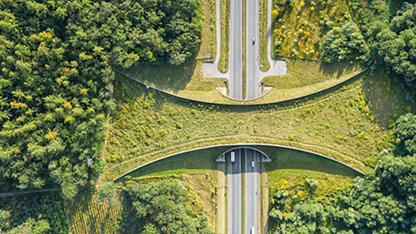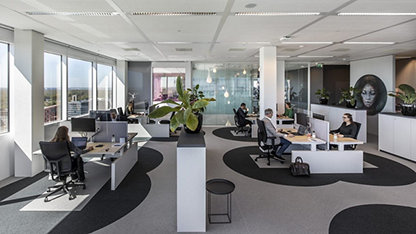On 12 April 2025, 08:00 BST, we will be disabling logins for specific member-facing platforms to improve internal processes. We expect this to finish 12 April 2025 at 17:00 BST.
The built environment has a significant impact on well-being. We build hospitals to treat patients, design educational institutions to maximise learning, and develop infrastructure and public spaces to connect communities. However, we must give the same consideration to the well-being of those working in the built environment sector as we do to the end users of our projects.
The health and well-being of the working population has huge financial implications. The Health and Safety Executive reported that 1.4m people in Great Britain were suffering from work-related illness in 2017/18. This had an estimated cost to the economy of £15bn. Sickness absence in the UK is estimated to cost employers more than £29bn a year. It is thought that the cost of presenteeism, that is coming to work when unwell, may be over twice that of absenteeism – so the true financial cost of ill health to UK business is likely to be even higher than estimated.
In 2017, the UK government commissioned a review of how employers could better support the mental well-being of their employees. The report estimated the annual cost of poor mental health to employers to be between £33bn and £42bn, with a cost to the UK economy of £74bn to £99bn per year. These figures incorporate reduced productivity, increased employee turnover and absenteeism in the workplace, and the wider costs of treatment and support for those out of work due to mental ill health.
Traditionally, organisations have focused more on safety than on health. While the Health and Safety at Work etc Act 1974 and the Management of Health and Safety at Work Regulations 1999 placed responsibility on employers to manage both health and safety, very often the focus was on the short term. Organisations weighed up the impact of ‘fast’ versus ‘slow’ accidents; for example, falling from height can kill someone instantly, whereas inhaling silica dust may kill 20 years after initially exposure. In 2017–18, there were 19 deaths in the construction industry related to falling from height, but 3,500 deaths from work-related cancer, thought to be predominantly caused by previous asbestos and silica exposure. Whether the motivation is legal or moral, there is clearly a need to prevent workplace ill health.
The Construction (Design and Management) Regulations (CDM) 2015 place specific responsibilities on the client, principal designer, principal contractor, contractors and workers in relation to both health and safety. The regulations require risks to be eliminated, reduced or controlled throughout the entire lifecycle of a building or project. While each stakeholder has their own defined role under CDM, cooperation and collaboration should be sought to share knowledge so health risks are identified and eliminated.
Having traditionally focused on protecting workers from physical injury or illness, over the past decade health and safety training has increasingly included mental health. In 2017, the Office for National Statistics produced its first report on suicide by occupation in England. The report revealed that the construction industry accounted for more suicides than any other industry between 2011 and 2015, with 1,409 men and ten women dying by suicide during that period. The risk of suicide in low-skilled male construction workers was three times the national average, and skilled finishing trades, such as painters and plasterers, were twice the national average. These sobering statistics have acted as a wake-up call for the industry to focus on both physical and psychological health, safety and general well-being.
Well-being is a broad term, and often misused. The International Labour Organization states that, ‘Workplace well-being relates to all aspects of working life, from the quality and safety of the physical environment, to how workers feel about their work, their working environment, the climate at work and
“Organisations can sometimes struggle to address well-being strategically – and addressing all the factors that affect an employee’s well-being can seem like an insurmountable challenge ”
Organisations can sometimes struggle to address well-being strategically, and addressing all the factors that affect an employee’s well-being – physical, psychological and social – can seem like an insurmountable challenge. Breaking them down into the following, non-exhaustive, sections and subsections can be helpful:
- working relationships: senior management, line managers, peers, clients, customers
- management of occupational health risks: dust, noise, vibration, hazardous substances, air quality, temperature, workstation set-up
- welfare provision: toilets, washrooms, storage for personal belongings, access to health foods, space for relaxation and privacy
- working arrangements: working hours, shift patterns, flexible working, travel times, access to sick pay, parental leave
- access to healthcare: occupational health service, public health services such as time off for healthcare appointments, private medical insurance, employee assistance programmes
- workplace culture: does the organisation encourage employees to raise concerns? Are concerns acted on?
These sections and subsections can then form the basis of the following key ideas, which are shown in practice in the Mace case study.
- Leadership: the support of those in leadership roles is critical to the uptake and sustainability of a health and well-being programme, ensuring successful delivery and engagement with the strategy.
- Data: a robust measurement of well-being can be achieved through employee surveys. These should consist of academically validated questions designed to ensure that the right topics are being addressed to achieve the desired outcome. The data can then provide a clearer understanding of the risks and opportunities relating to well-being and help to put together a business case for well-being investment.
- Strategy: once a greater understanding of employee well-being is achieved, a long-term plan to address health and well-being risks can be developed and cemented as part of a responsible business strategy.
- It is important to define how your organisation considers well-being, including examples of actions
- and results in those definitions.
- Ongoing management and measurement: key performance indicators (KPIs) can then be set to track health and well-being and the effectiveness of the strategy. Benefits to employees as well as commercial benefits can then be demonstrated.
- Engagement: for a well-being strategy to be sustainable, there must be collaboration. This means all areas of a business must work together under the leadership of the well-being team, adhering to the agreed principles, and working out how the practices can be applied to their area of work.
- Benchmarking: it is important to be aware of where your strategy sits in the context of the industry. Work with external organisations such as academic institutions, meet with your peers, and sign up to relevant initiatives to ensure that your business is doing all it can to develop an open culture, with well-being at the heart of its policies.
There are many ways that the construction sector can address health and well-being at work, but the key ideas listed above and explored in the case study can help you to create a sustainable health and well-being strategy. We can all make a contribution towards improving health and well-being at work and identifying any work-related health risks. Effective management of people and processes will help us address the impact that our actions have on others. After all, the way that we treat people may turn out to have the greatest impact of all on employee health at work.
Case study: Well-being at Mace
Leadership
In 2017 our health and safety team became the health, safety and well-being team, and the organisation created the role of director of health and well-being, replacing the traditional focus on occupational health with a more strategic approach to health and well-being. The board’s support has been vital to the successful delivery of – and engagement with – our health and well-being strategy, and in driving this cultural change.
Data
Mace partnered with leading business psychologists and well-being experts Robertson Cooper to gain a baseline understanding of well-being in the organisation. A total of 68 per cent of our employees completed the survey, providing a valuable insight into health and well-being drivers.
Strategy
Well-being now forms part of Mace’s responsible business strategy and 2022 Business Strategy, and health and well-being is considered in three areas.
- Occupational health is often reactive, ensuring that employees are fit for work and have the necessary health checks. This, along with human resource expertise, helps employees stay in work despite ill health, or return to work following ill health. Occupational health can also be proactive by offering employee health checks to identify potential future illnesses.
- Occupational hygiene is proactive and preventative. Occupational hygienists support clients, designers and contractors to identify potential risks and then eliminate, minimise or control them.
- Well-being is about health promotion. Mace’s well-being calendar includes topics such as mental health, stress, suicide, lung health, diabetes, fatigue, alcohol and sleep. There are well-being ambassadors and trained mental health first aiders, an annual Well-being Week, access to volunteer opportunities and a nominated charity of the year.
Using the data collected, we developed a five-year plan to address health and well-being risks focusing on: managing health risk, creating well-being opportunities, using thought leadership to share and benchmark, healthy buildings, and community well-being.
Management and measurement
KPIs help to track health and well-being. Our online platform was adapted to include more on well-being, allowing for recording of health and well-being activities. Guidance has been provided so that work sites can implement activities based on their local health and well-being data from our survey and risk assessment. Tracking these activities will allow us to accumulate examples of good practice and realise the benefits of our well-being initiatives, for our employees and our supply chain. Results from our surveys revealed a clear link between well-being and productivity, presenteeism and turnover.
Engagement
The health, safety and well-being team has worked with human resources and the responsible business team to develop its approach and draw on different areas of expertise. For example, the work that the responsible business team does to improve air quality directly benefits the health of those working on our projects. Likewise, our manager training programme is designed to equip managers with the skills and resources to support, develop and communicate with their teams – all skills that directly affect the well-being of employees. Working with our procurement team, we also ensure that procedures are in place to check the competence of our supply chain in relation to health and safety; and our building services team now considers health and well-being in our office space design.
Benchmarking
A master’s degree student from King’s College London researched the effectiveness of our Mental Health First Aid programme and another student interviewed site workers to understand what well-being meant to them. The results of both ventures will be used to further develop our strategy. We meet with our peers, supply chain and organisations outside our sector to share ideas and have signed up to the Time to Change pledge (time-to-change.org.uk) and the Building Mental Health charter (buildingmentalhealth.net). The aim is an open culture where employees are encouraged to speak out if they need help.
- Dr Judith Grant is director of health and well-being at Mace Group judith.grant@macegroup.com
- This article was first published in RICS Construction Journal (June/July 2019)






:16-9?$dpp-card-xxl$&qlt=85,1)












